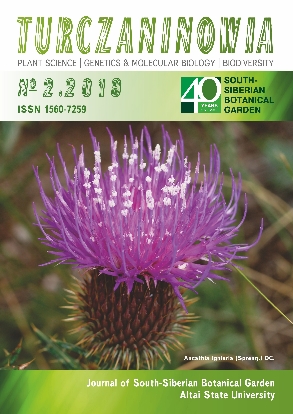Trapa manshurica var. rubra (Trapaceae), a new variety from Primorye Territory
Abstract
The description of the new taxonTrapamanshurica var. rubrafrom the Khasansky District, southern part of the Russian Far East, is given. This variety is characterized by more narrow horns than the type, the location of the fruits along the stem, the development of the swim bladder, and the presence of well-pronounced pigments in the color of petioles, stems, and fruits.
Downloads
Metrics
References
Берестенко Е. Н., Кислов Д. Е. Индикация представителей рода Trapa L. Приморского края по морфометрическим признакам плодов // Вестник Красноярского государственного аграрного университета, 2013. № 11. C. 94‒100.
Болотова Я. В. Распространение видов рода Trapa L. (Trapaceae) на территории Амурской области // Вестник Северо-Восточного федерального университета им. М. К. Аммосова, 2014. Т. 11, № 2. С. 22‒28.
Флеров А. Ф. Систематика и ботаническая география рода Trapa L. // Известия Главного ботанического сада РСФСР, 1925. Т. 24. C. 13–45.
Кобзарь А. И. Прикладная математическая статистика. М.: Физматлит, 2006. 816 с.
Крюкова М. В. Флора водоемов Нижнего Амура. Владивосток: Дальнаука, 2005. 160 с.
Куренцова Г. Э. Естественные и антропогенные смены растительности Приморья и Южного Приамурья. Новосибирск: Наука, Сибирское отделение, 1973. 230 с.
Lehmann E. L. 2006. Nonparametrics: statistical methods based on ranks. Springer, New York, 463 рp.
Ozero Doritsini [Lake Doritsini]. In: Gosudarstvennyy vodnyy reyestr [State water register]. URL: http://textual.ru/gvr/index.php?card=297547 (Accessed 22 November 2018).
Ozero Kaichegi [Lake Kaichegi]. In: Gosudarstvennyy vodnyy reyestr [State water register]. URL: http://textual.ru/gvr/index.php?card=297585 (Accessed 22 November 2018).
Пшенникова Л. М. Trapaceae // Флора российского Дальнего Востока. Владивосток: Дальнаука, 2006. С. 183‒185, 451.
Пшенникова Л. М. Новый вид рода Trapa (Trapaceae) с Дальнего Востока России // Бот. журн., 2007. Т. 92, № 1. С. 159–160.
Пшенникова Л. М., Берестенко Е. Н. Водяной орех маньчжурский (Траншеля) – Trapa manshurica Fler. // Красная книга Приморского края. Владивосток: АВК «Апельсин», 2008. C. 88.
Цвелев Н. Н. О роде Trapa L. (Trapaceae) в Восточной Европе и Северной Азии // Новости сист. высш. раст., 1993. Т. 29. С. 99‒107.
Цвелев Н. Н. Trapaceae // Сосудистые растения советского Дальнего Востока. Т. 7. СПб.: Наука, 1995. С. 241–244.
Васильев В. Н. Hydrocaryaceae // Флора СССР. Т. 15. М.‒Л.: Изд-во Академии наук СССР, 1949. C. 637‒662.
Васильев В. Н. Новые виды водяного ореха (Trapa L.) // Новости сист. высш. раст., 1973. Т. 10. С. 197‒211.
Turczaninowia is a golden publisher, as we allow self-archiving, but most importantly we are fully transparent about your rights.
Authors may present and discuss their findings ahead of publication: at biological or scientific conferences, on preprint servers, in public databases, and in blogs, wikis, tweets, and other informal communication channels.
Turczaninowia allows authors to deposit manuscripts (currently under review or those for intended submission to Turczaninowia) in non-commercial, pre-print servers such as ArXiv.
Authors who publish with this journal agree to the following terms:
- Authors retain copyright and grant the journal right of first publication with the work simultaneously licensed under a Creative Commons Attribution License that allows others to share the work with an acknowledgement of the work's authorship and initial publication in this journal.
- Authors are able to enter into separate, additional contractual arrangements for the non-exclusive distribution of the journal's published version of the work (e.g., post it to an institutional repository or publish it in a book), with an acknowledgement of its initial publication in this journal.
- Authors are permitted and encouraged to post their work online (e.g., in institutional repositories or on their website) prior to and during the submission process, as it can lead to productive exchanges, as well as earlier and greater citation of published work (See The Effect of Open Access).





